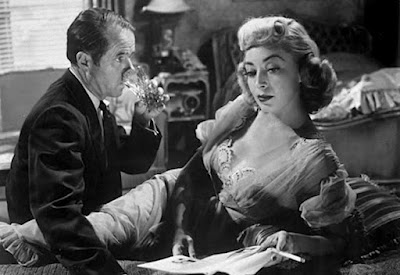 |
| Frances McDormand, Billy Bob Thornton, "The Man Who Wasn't There" (2001). |
Why Did an Acclaimed Coen Brothers NoirTank at the Box Office?
Contains Spoilers
By Paul Parcellin
‘The Man Who Wasn’t There’ (2001)
Ed Crane (Billy Bob Thornton) is the kind of guy who can enter or leave a roomful of people without a single soul taking notice. He’s got a knack for blending into the background, barely leaving an impression with anyone who cares to chat or even glance in his direction. Potted plants make a bigger splash at a party than Ed.
On-screen, he utters few words, but in the film’s voice-over narration, which Ed delivers with a laconic edge of existential dread, he’s a blabbermouth, relatively speaking. His patter fills in the story’s blank spots as he offers wisps of gossip and terse assessments of the people in his life. In Billy Bob Thornton’s wonderfully restrained performance, Ed smokes and listens while others do the talking.
It’s an intriguing if odd setup for a noir, for sure. Still, “The Man Who Wasn’t There” had a lot going for it, yet, audiences didn’t warm up to the film and the reasons for that are buried in the details. (More about that later).
Ed cuts hair in his brother-in-law, Frank Raffo’s (Michael Badalucco) barbershop and barely pays attention as Frank yammers on incessantly about Canadian fur trappers, Russian A-bombs and the like. That Ed is chained to a motormouth of Frank’s intensity is a textbook example of what hell on earth might be like. It’s the core of the film’s darkly humorous undercurrent, where the line between comedy and tragedy is as thin as a straight razor’s honed edge.Ed’s wife, Doris (Frances McDormand), has a drinking problem and is having an affair with her blowhard boss, Big Dave Brewster (James Gandolfini), who runs a local department store where Doris keeps the books.
Ed and Doris live in a modest suburban bungalow in Santa Rosa, Calif., and in the voice-over he sums up his domestic life without a trace of enthusiasm: “The place was OK, I guess; it had an electric ice box, gas hearth and a garbage grinder built into the sink. You might say I had it made.”
 |
| Ed Crane plies his trade. |
Despite his lethargy, a spark of ambition still smolders within Ed. He wants to do something with his life, but thus far the dark cloud hovering over his head keeps him from making a move.
 |
| Jon Polito as Creighton Tolliver |
He successfully blackmails Big Dave with anonymous threats to expose Dave’s affair with Doris, then hands the loot over to Tolliver, buying his way into the dry cleaning business. This is the stuff of a James M. Cain or Raymond Chandler novel, dripping with dramatic possibilities, including marital infidelity, icy indifference to murder and larger than life characters with a yen for quick cash.
Overall, the critical reception was positive. Joel Coen won the Best Director award at the 2001 Cannes Film Festival. The BBC, the Guardian, the Austin Chronicle and the National Board of Review all named it one of the best films of the year. Roger Deakins was nominated for Best Cinematography at the Oscars. Yet upon its initial theatrical release, “The Man Who Wasn’t There” failed to catch on with the public.
 |
| James Gandolfini, as Big Dave Brewster. |
 |
| Tony Shalhoub as Freddie Riedenschneider |
But the film’s highest trump card is its authentically 1940s atmosphere, due in large part to Deakins’ classic noir lighting techniques, bathing the frame in inky black shadows while paying homage to iconic noir images, including:
- “Phantom Lady” (1944): Ella Raines and Alan Curtis appear in near silhouette, a flood of sunlight to their backs visually isolates them in an otherworldly domain. Similarly, in “The Man Who Wasn’t There,” Atty. Freddie Riedenschneider (Tony Shalhoub) is bathed in a beam of light filtering down through a skylight as he confers with Doris and Ed.
- “Scarlet Street” (1945): Milquetoast Christopher Cross (Edward G. Robinson) gives Kitty March (Joan Bennett) a pedicure, much the way that Ed shaves Doris’s legs as she luxuriates in the bathtub. Both shots emphasize that the men are subservient to conniving women.
- “The Postman Always Rings Twice” (1946): Femme fatale Cora Smith (Lana Turner) and Frank Chambers (John Garfield), have a car wreck on a quiet country road, much like the crash that occurs near the end of “The Man Who Wasn’t There.”
 |
| Scarlett Johansson as Birdy, and Billy Bob Thornton as Ed Crane. |
They travel together to San Francisco where Birdy is to audition for a big shot piano instructor, which turns out to be a bust. As they return home, a confused Birdie, guilty over her failed audition, tries to give Ed some unwanted sexual gratification as he’s negotiating the turns of a country road, causing the car to wreck. The accident, almost a carbon copy of the one in “The Postman Always Rings Twice,” injures them both and dooms Ed.
 |
| Roger Deakins' classic noir lighting. |
Audiences may have been put off by Ed's opaque motivations, many of which are open to speculation. We are left to wonder what dramatic turn in Ed’s life caused him to recede into the background and become a spectator, viewing the events of his life from a distance like a shy apparition, taking it all in and sending out little. The answer is likely buried so deeply that Ed himself doesn’t know, and that’s the way it will stay for eternity.
Is "The Man Who Wasn't There" a film noir homage or is it satire? It's both, because you couldn't create such a smartly detailed satire without having an abiding love and admiration for the original material on which it is based. But you can take it either way. As Ed might say, it doesn't matter much to me.




























